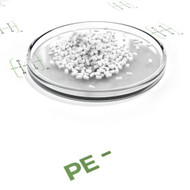Polyethylene PE: Mechanical Strength and Chemical Resistance
History
Polyethylene (PE) is a major commodity plastic and the second most widely used thermoplastic after polypropylene (PP). Several types of PE exist and are classified according to their density, ranging from 0.88 to 0.96 g/cm3: linear low-density PE (LLDPE), low-density PE (LDPE), medium-density PE (MDPE), and high-density PE (HDPE).
Polyethylene was first discovered accidentally in the late 1890s by a German chemist exploring diazomethane and later in the 1930s in an industrial setting by British chemists working for Imperial Chemical Industries (ICI). By 1935, a reproducible process of synthesizing PE was established within ICI, with industrial production of LDPE beginning in 1939. However, the outbreak of World War II halted PE production until 1944, when it resumed at DuPont and Union Carbide Corporation in the USA under license from ICI.
Quick Highlights
- Polyethylene (PE) is a major commodity plastic and the most widely used thermoplastic after polypropylene (PP).
- PE was discovered accidentally in the late 1890s, but commercial production began only in 1944.
Synthesizing
Where initial processes relied on extremely high pressures to produce LDPE, later developments involved catalysts that allowed the polymerization reaction to occur under mild conditions, thus enabling the controlled synthesis of a range of PE possessing distinct characteristics. Such innovations include Phillips’ chromium-based catalyst and Ziegler’s improved titanium-based catalytic system; by the 1950s, both systems were interchangeably utilized in the industrial production of HDPE. Further advancements came with Kaminsky and Sinn’s introduction of metallocene-based catalysis in the late 1970s. Together with the Ziegler system, these catalysis methods represent the basis of how a range of PE resins are synthesized to this day.
Like many thermoplastics, PE is a downstream product of the petrochemical industry. However, it may also be derived from the dehydration of ethanol. The starting monomer required for PE synthesis is ethylene, also known as ethene, which is a gaseous hydrocarbon. Being a stable molecule, its polymerization requires incredibly high-pressure systems (early processes) or the use of catalysts (Phillips/Ziegler/Kamisky’s catalytic systems).
Quick Highlights
- PE is a downstream product of the petrochemical industry. The monomer required is ethylene, a gaseous hydrocarbon, which requires either high-pressure systems or catalysts for its polymerization into PE.
- Ziegler’s Titanium-based catalytic system and Kaminsky’s metallocene-based system remain the most widely used methods for synthesizing PE to this day.
Properties
The properties of PE may vary depending on the process conditions, molecular weight, and molecular weight distribution. Additionally, these properties may be fine-tuned through crosslinking or copolymerization. PE’s characteristics, such as being cost-effective, non-toxic, and exhibiting excellent chemical resistance, make it a popular choice for a range of applications. Nonetheless, its primary use remains in packaging, with key examples including plastic bags, bottles, and cups.
Since the type of PE dictates its characteristics, considerable effort has been invested in controlling the synthesis of various kinds of PE. Most types, including LDPE, HDPE, and MDPE, exhibit excellent chemical resistance to strong acids and alkalis, as well as mild oxidants and reducing agents. However, they are susceptible to degradation by aromatic hydrocarbons or chlorinated solvents. As a highly non-polar material, it repels water and has low moisture permeability, making it suitable for electrical insulation applications. However, it allows for gas exchange, meaning that flavorings, oxygen, and carbon dioxide can pass through it.
Quick Highlights
- The properties of PE depend on its configuration, process conditions, molecular weight, and molecular weight distribution; these characteristics may be fine-tuned through cross-linking or copolymerization.
- Most PE types (including LDPE, HDPE, and MDPE) exhibit excellent chemical resistance to strong acids/alkalis and mild oxidants/reducing agents; however, they are prone to degradation by aromatic hydrocarbons or chlorinated solvents.
- PE repels water and has low moisture permeability, making it suitable for electrical insulation applications; it also allows for gas exchange, meaning oxygen, flavoring, and carbon dioxide can pass through it.

Performance Polymer
Polyethylene melts in the temperature range of 105–115 °C (221–239 °F) for LDPE and 120–130 °C (248–266 °F) for MDPE, with 144–146 °C (221–239 °F) being the theoretical limit reported for PE. It demonstrates low thermal conductivity and can, therefore, be used as an insulator in applications where heat transfer needs to be minimized. Additionally, it demonstrates a low dielectric constant, which makes it an effective material for high-frequency insulation needs, as it will minimize energy loss. PE also exhibits a high thermal expansion rate, allowing it to change shape with varying temperatures. PE burns slowly and does not easily support fire spread; the material will continue to burn even after the removal of the flame source, melting rather than charring, producing a drip.
Quick Highlights
- LDPE melts at 105–115 °C, whereas higher-density PEs have higher melting points, reaching up to 144–146 °C (221–239 °F).
- PE demonstrates low thermal conductivity, a low dielectric constant, and a high thermal expansion rate.
Mechnical & Chemical Properties
LDPE (defined by densities in the range of 091–0.94 g/cm3) exhibits high degrees of branching in the polymeric structure, meaning the polymer chains do not pack as efficiently into the crystal structure. As a consequence, the material is soft and flexible, exhibiting increased ductility and a lower tensile strength than other types of PE. These characteristics make it suitable for applications such as plastic bags and squeezable bottles. LDPE also exhibits the greatest transparency among PE types.
On the other hand, HDPE (density ≥ 0.94 g/cm3) is more rigid and exhibits a higher tensile strength. By using specific catalysts and reaction conditions, the degree of branching can be controlled and minimized, thus achieving a more efficiently packed crystal structure, which gives HDPE its rigidity and strength, albeit with lower transparency. These characteristics make HDPE ideal for applications like detergent bottles, garbage containers, and water pipes.
Quick Highlights
- Higher degrees of long-chain branching mean less efficiently packed crystal structures. This translates to softer, more flexible materials with lower impact resistance and increased transparency, such as LDPE.
- Using specific conditions, branching is minimized when producing HDPE such that it is rigid and exhibits improved strength.
Other Properties
LLDPE (defined by densities in the range of 0915–0.925 g/cm3) was synthesized such that it combines flexibility with strength. It demonstrates improved resistance compared to LDPE, including improved stress-cracking and puncture resistance. However, it is more challenging to process. Its relative transparency and strength enable LLDPE’s application for cable coverings and film applications such as Saran wrap or bubble wrap.
For high-performance applications, an extremely tough type of polyethylene was developed, namely Ultra-High Molecular Weight Polyethylene (UHMWPE). Its toughness and excellent wear, impact, and chemical resistance result from its high molecular weight, although this also leads to a less efficiently packed crystal structure and lower densities than HDPE. Notable applications include bearings, gears, artificial joints, and butcher’s chopping boards.
Quick Highlights
- LLDPE combines flexibility with strength, making it suitable for film applications such as Saran or bubble wrap.
- UHMWPE was developed for excellent wear, impact, and chemical resistance, enabling its use in applications, e.g., bearings and gears.
Sustainability
Polyethylene is highly recyclable, particularly LDPE and HDPE, which can be easily melted and remolded. However, this process is dependent on proper sorting and handling. As a non-biodegradable material, PE may pose a significant environmental impact, highlighting the need for efficient waste and energy consumption management to limit its environmental footprint
Quick Highlights
- PE is highly recyclable but non-biodegradable.
- Efficient waste and energy consumption management is essential to balance commercial benefits with minimizing environmental impact.





